A Kawarthas Summer Nature Almanac
With summer almost upon us, I want to look ahead to some of the events in nature that we can expect over the next three months. As for the long-term weather forecast, normal to above-normal temperatures are expected this summer, according to Dave Phillips of Environment Canada. A wetter and muggier summer is likely, as well.
It seems that interest in birding – and nature in general – is going through something of a renaissance these days. It may be that the pandemic has given people the time and opportunity to pay more attention to the natural world. For anyone new to birding, I would like to encourage you to take advantage of eBird. It is an online checklist service that allows you to find more birds; keep track of your bird lists, photos, and sounds; explore the latest sightings in the Kawarthas and around the world; be a part of the world’s largest birding community; and contribute to science and conservation. You can also receive email alerts that let you know when and where rare species or birds you have not yet personally recorded in a given area – Peterborough County, for example – have been observed. In addition to being free, I love eBird because it connects me with other birders and allows me to plan where to go birding. You can submit a checklist for all kinds of birding, be it a couple of hours in the field, something that turns up in your backyard, or just a species of interest that flies across the road while you’re driving. The bottom line is that it’s fun and will make you a better birder. You’ll also get a much better sense of the bird diversity we enjoy both in the Kawarthas and around the world. It is the first resource I go to when travelling. See eBird at https://ebird.org/home
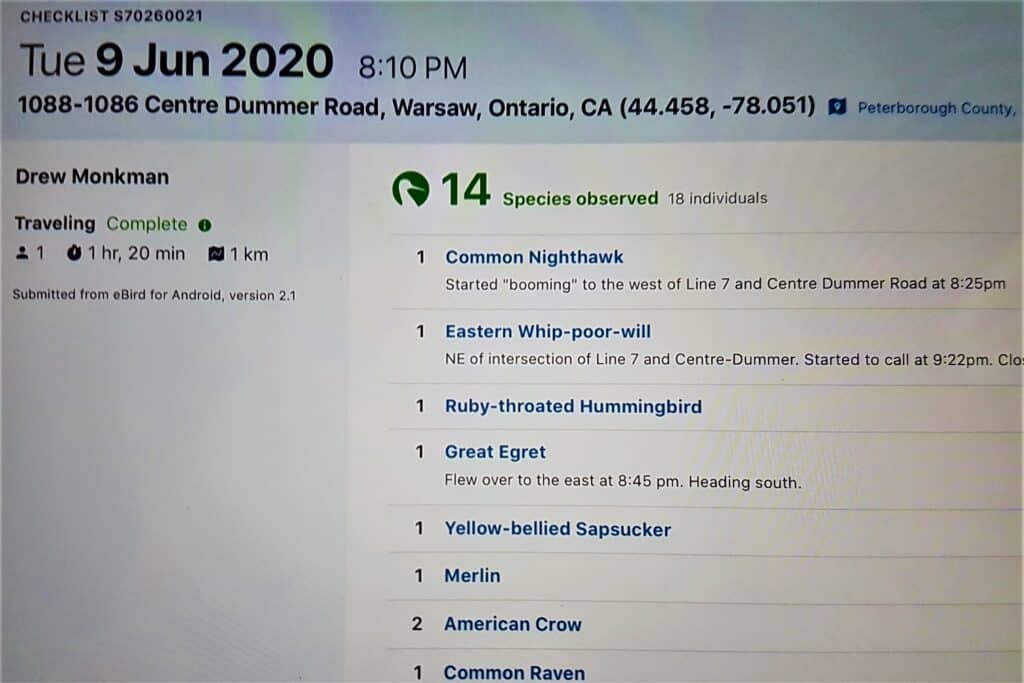
Late June
- Saturday, June 20, marks the summer solstice. The sun rises and sets at its furthest points north. It is almost directly overhead at noon.
- Turtles can still be seen along roadsides and rail-trails laying their eggs. Remember to slow down in turtle habitat.
- Monarch butterflies have returned – the “grandchildren” of those that flew to Mexico last fall. The first one I heard of this year turned up on May 28.
- Late June nights are alive with fireflies. The male will typically fly low over a meadow and flash his heatless light in a specific pattern, colour and duration. The female then responds with her own luminous signal.
- Butterfly abundance moves into high gear in late June. Tiger swallowtails and white admirals are particularly noticeable already. Sandy Lake Road (off County Road 46) is a great area to see rarer butterflies such as some of the skippers.
- Early summer is a good time to learn the common, non-native invasive plants. Some of the most noticeable road- and trail-side species are wild parsnip, dog-strangling vine and Phragmites (common reed). For more information, go to the Ontario Invasive Plant Council website at ontarioinvasiveplants.ca. At a time when the impact of invasive species is only getting worse, OIPC funding was eliminated in the 2019 Ontario Budget.
- Cedar waxwings nest any time between late June and early August as berry crops, their main source of food, begin to ripen. In late June and early July, reddish-purple serviceberries are a common source of food.
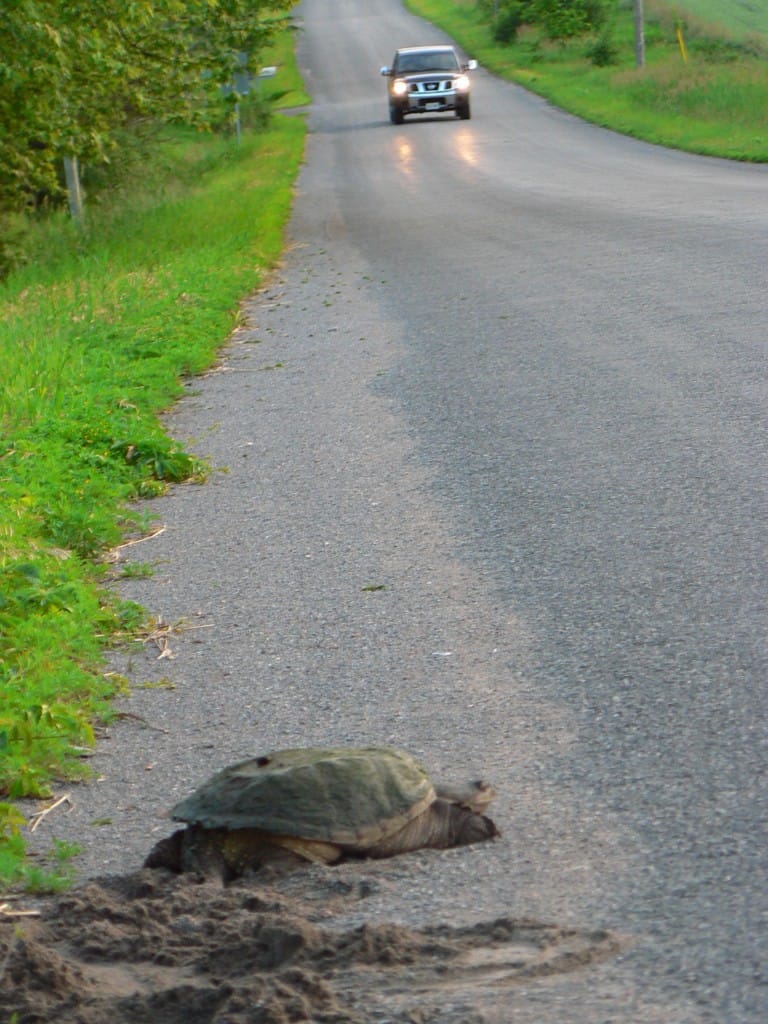
July
- Common mergansers are often seen feeding and traveling along shorelines on lakes in the northern Kawarthas. Because broods of mergansers sometimes combine, it is not uncommon to see a female with a parade of 20 or more young in tow.
- Common milkweed is in flower and its rich, honey-sweet perfume fills the early summer air. The scent serves to attract insects whose feet will inadvertently pick up the flowers’ sticky pollinia – small packets containing pollen – and transfer them to another plant.
- A huge number of other plants are blooming, as well. In wetland habitats, watch for common elderberry, swamp milkweed, Joe-Pye weed, yellow pond lily, and fragrant white water lily. Along roadsides and in meadows, common species include bird’s-foot trefoil (often on lawns), ox-eye daisy, yarrow, viper’s bugloss, black-eyed Susan, Queen Anne’s lace, purple-flowering raspberry, and orange hawkweed.
- July is infamous for deer, horse, and stable flies, which belong to the Tabanidae family. Deer flies have black-patterned wings, iridescent eyes and tend to fly around your head. Horse flies are larger, grey in colour, and have huge eyes. They prefer to bite lower on the body. Stable flies are house fly-size and have four dark stripes on the thorax. They often attack the ankles and are difficult to swat. Stable flies lay their eggs on rotting vegetation along shorelines and often show up at cottage docks.
- Identifying and photographing dragonflies is a wonderful way to spend a summer afternoon. Among the most common July species are the dot-tailed whiteface, common whitetail, four-spotted skimmer, and chalk-fronted skimmer. Some of the most frequently seen damselflies are powder-blue in colour, hence the common name of “bluets.” Go to https://www.odonatacentral.org/#/ for pictures of all Ontario dragonflies and damselflies. Click on “Species Lists” and then “Filter Results”. Type “Ontario, Canada” in the location box.
- By mid-July, the buzzy, electric song of the dog-day cicada fills the void created by the decrease in bird song.
- Mid-summer is a wonderful time to enjoy the wide abundance of ferns that we have in the Kawarthas. The Warsaw Caves Conservation Area, Silent Lake Provincial Park, and the Ingleton-Wells Trail at Viamede on Stoney Lake are three of my favourite fern destinations.
- Late July through September offers some of the best shorebird watching of the year. Semipalmated sandpipers, pectoral sandpipers and greater yellowlegs are several of the most commonly seen species.
- The ghostly-white Indian pipe blooms in the heavy shade of hardwood forests.
- Being opposite the high-riding summer sun, the summer moon travels low in the southern sky. This translates into the longest moon shadows of the year.

12-spotted Skimmer 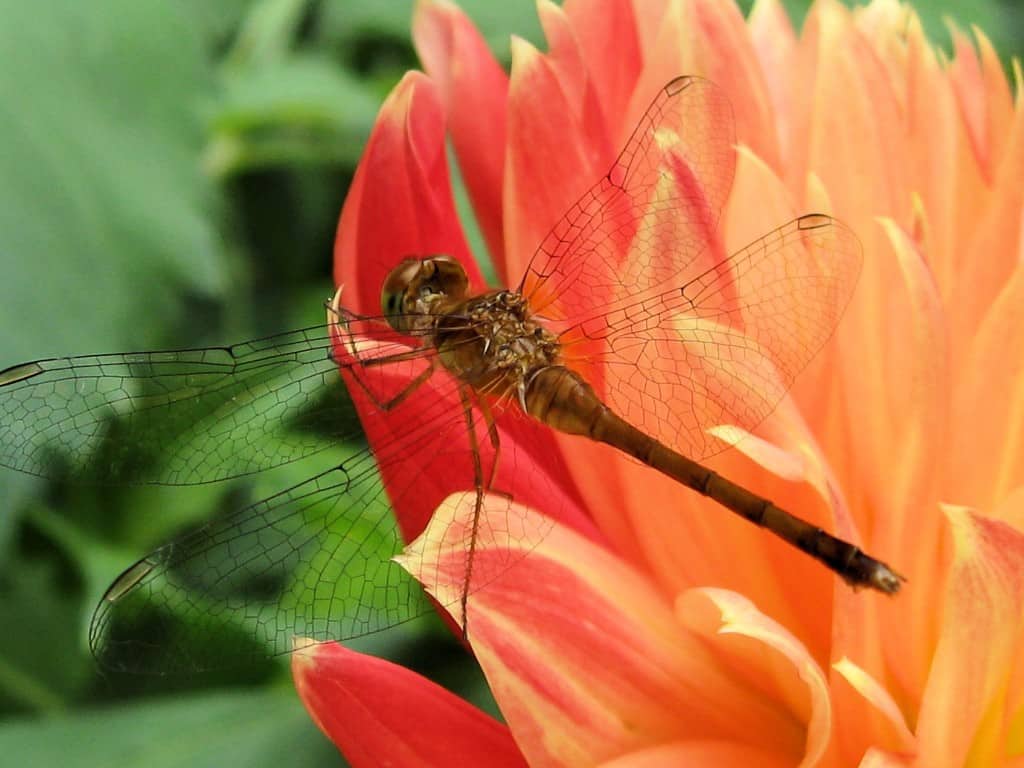
Immature meadowhawk dragonfly – Margo Hughes 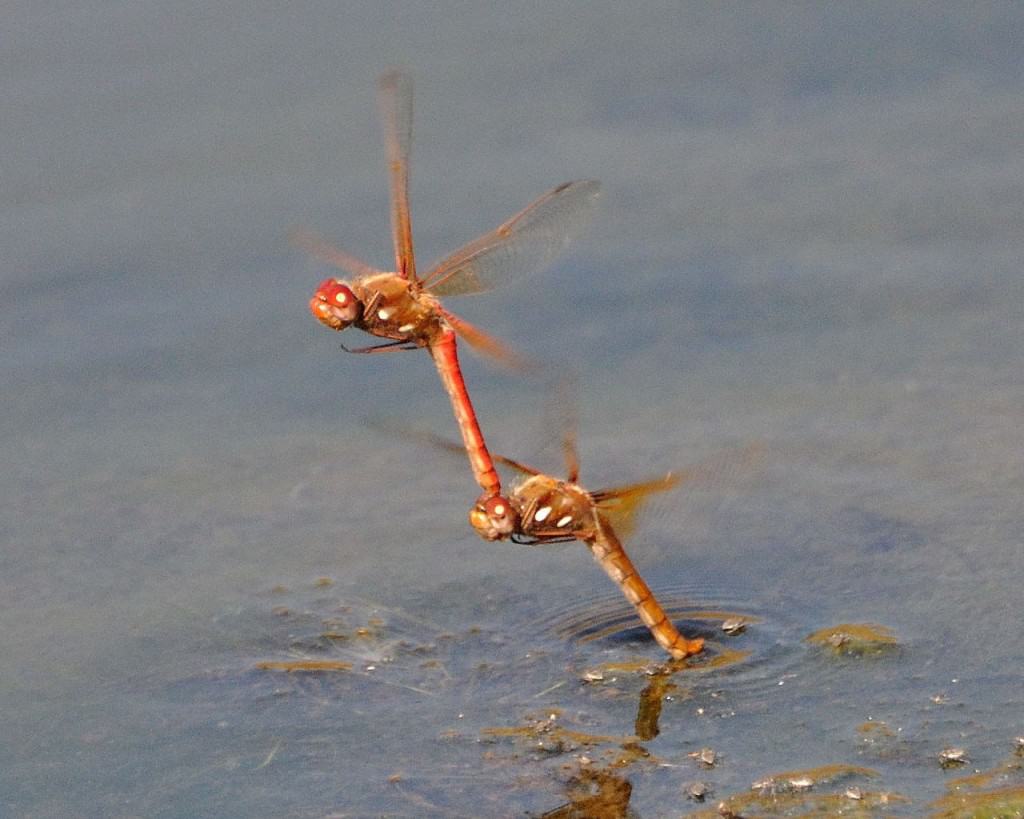
Male dragonfly clasping onto female as she lays eggs – Dan Debold
August
- Cottagers sometimes find large, mysterious, jelly-like “blobs” attached to the dock or aquatic plants. They are formed by colonies of Bryozoa, a freshwater invertebrate. Looking somewhat like an egg mass, the clumps are clear, dense, and have distinct repetitive patterns and markings on the outside.
- Listen for the high-pitched “lisping” calls of cedar waxwings. These birds often perch on the branches of dead trees and sally out to catch flying insects.
- August is a good time to check milkweeds for the yellow-, black-, and white-striped caterpillars of the monarch butterfly. They are easy to rear in captivity and provide adults and children alike with a first-hand lesson in insect metamorphosis.
- Small dragonflies known as meadowhawks abound. Mature males are red, while females and immature males are yellowish.
- A large percentage of the insect music we here this month comes courtesy of crickets and katydids. For example, the soft, rhythmic “treet…treet…treet” of the snowy tree cricket sounds like a gentle-voiced spring peeper. Its beautiful rhythmic pulsations provide a good estimate of air temperature. Watch and listen at bit.ly/18nGrJ3
- Bird migration is in full swing by mid- to late August, with numerous warblers, vireos, flycatchers, and common nighthawks moving through. One of the best places to see nighthawks is Back Dam Park near Warsaw. Migration peaks around August 20 but continues into the first week of September. Go in the evening and watch the sky for loose flocks.
- Keep an eye out for underwing (Catocala) moths, named for the bright colours of the underwings. The forewings, however, which often hide the underwings, look very similar to bark.
- Goldenrods reach peak bloom at month’s end and become the dominate flowers of roadsides and fields. These plants are veritable insect magnets.
- Late summer sees a spike in wasp numbers. Because workers must collect protein for the larvae in the nests, they are invaluable in controlling the many garden pests on which they prey. Wasps are also important pollinators.
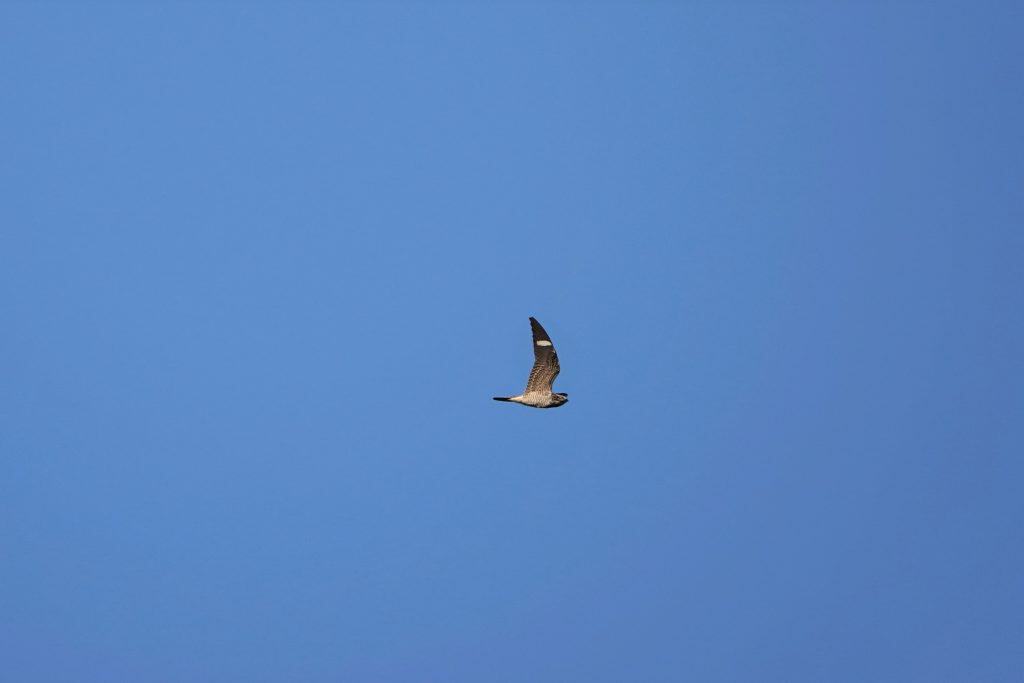
Nighthawk soaring over Back Dam Park – Drew Monkman 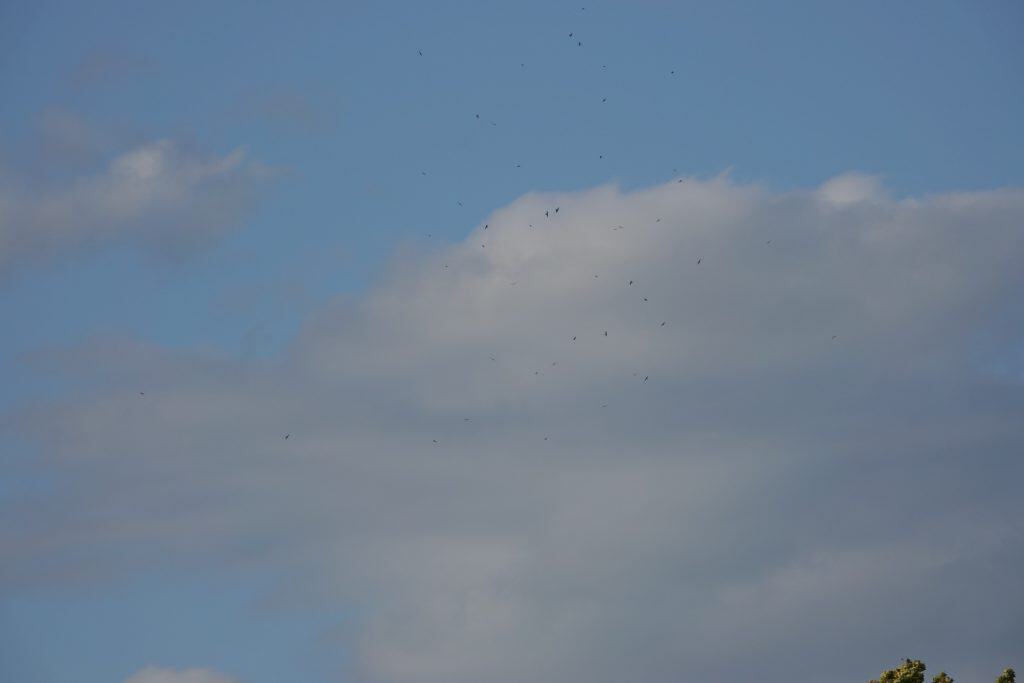
A loose flock or “kettle” of about 48 nighthawks at Warsaw on August 29, 2019 – Drew Monkman
September
- Monarch butterfly numbers are at their highest. Monarchs congregate at peninsulas on the Great Lakes such as Presqu’ile Provincial Park, a jumping off point for their migration across Lake Ontario.
- Chinook and coho salmon leave Lake Ontario to spawn in tributaries of the Ganaraska River. Huge salmon can be seen jumping up the fish ladder at Corbett’s Dam on Cavan Street in Port Hope.
- By late September, asters reign supreme. Their purples, mauves, and whites light up fields and roadsides and bring the year’s wildflower parade to a close. Watch especially for New England, heath, panicled, and heart-leaved asters. They make a great addition to any pollinator garden.
- Most years, Virginia creeper vine, poison ivy, chokecherry, and staghorn sumac reach their colour peak at about the fall equinox, which occurs this year on September 22.
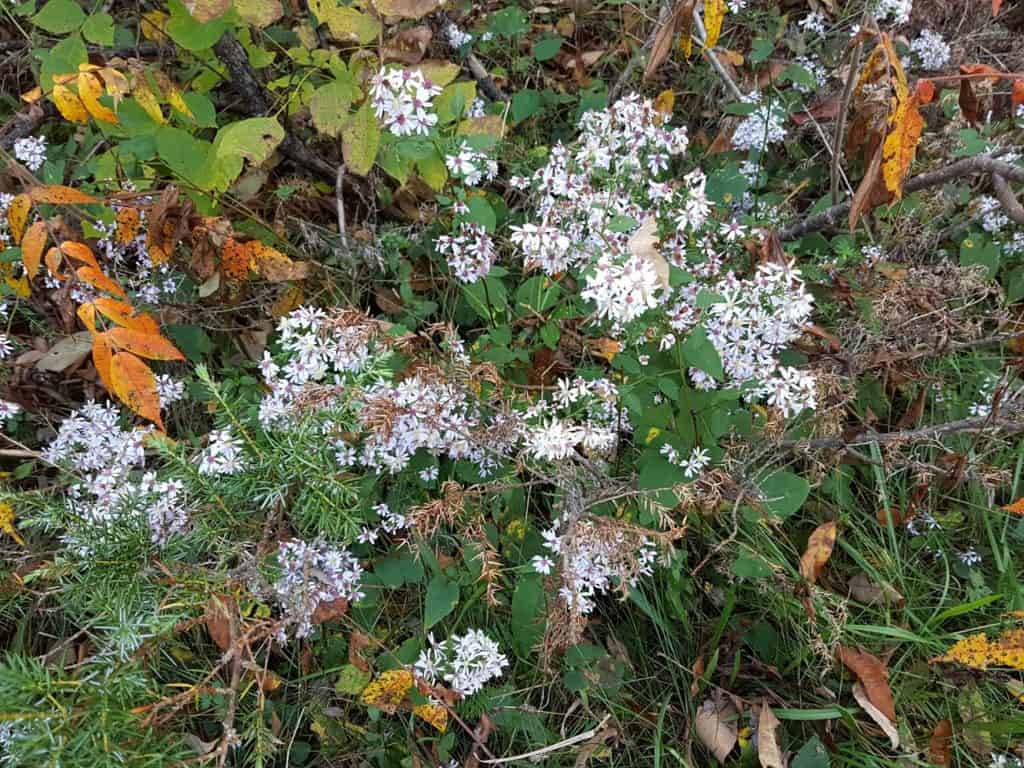
Heart-leaved Asters – Drew Monkman 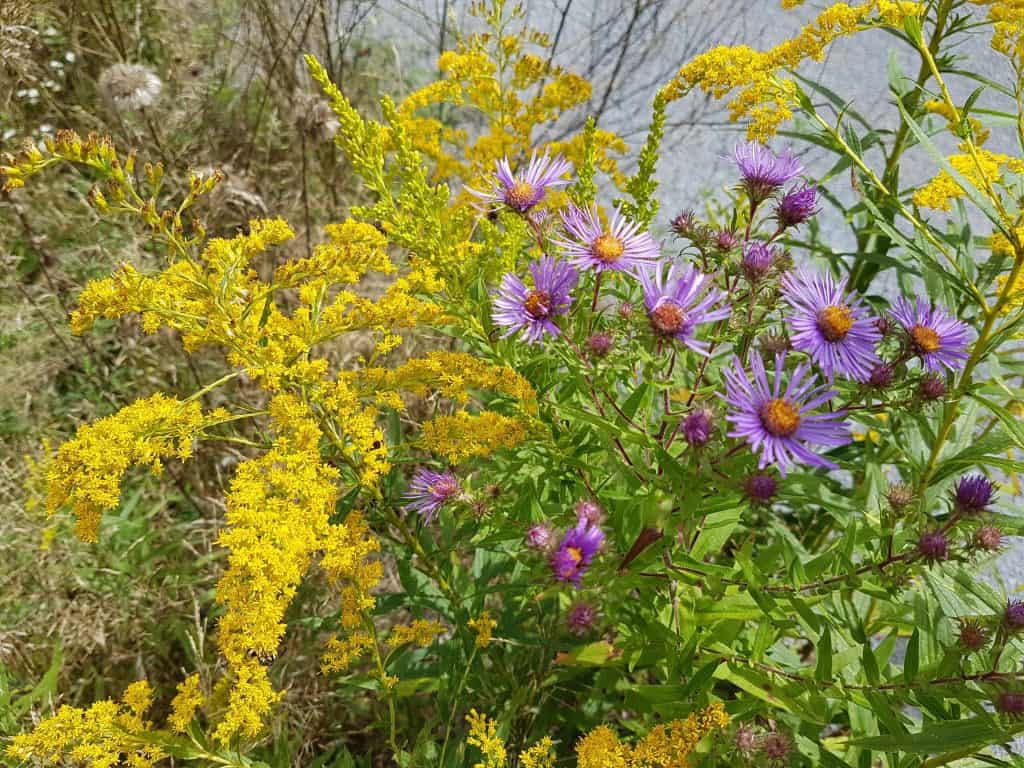
Canada goldenrod (left) and New England aster (photo by Drew Monkman)
CLIMATE CRISIS NEWS
OUTRAGE: A new report by Environment and Climate Change Canada https://bit.ly/30K6BFX confirms that climate change has made rainfall events more frequent, more severe, and the cause of billions of dollars of damages. It also notes a marked increase in claims from extreme weather damage in Canada. It stated that so-called ‘one-in-20, 50 or 100-year’ events can be expected to occur with far greater frequency with just a 1C temperature increase over pre-industrial averages. Earth is now approaching 1.3C of warming.
OPTIMISM: Unilever NV is now the most ambitious of any consumer goods company when it comes to reducing carbon emissions. The maker of Dove skincare and Q-tips cotton swabs now aims to cut all emissions associated with its products by half by 2030 and to zero by 2039. Each of the company’s 70,000 products will also show on their labels how much greenhouse gas was emitted during manufacturing and shipping.